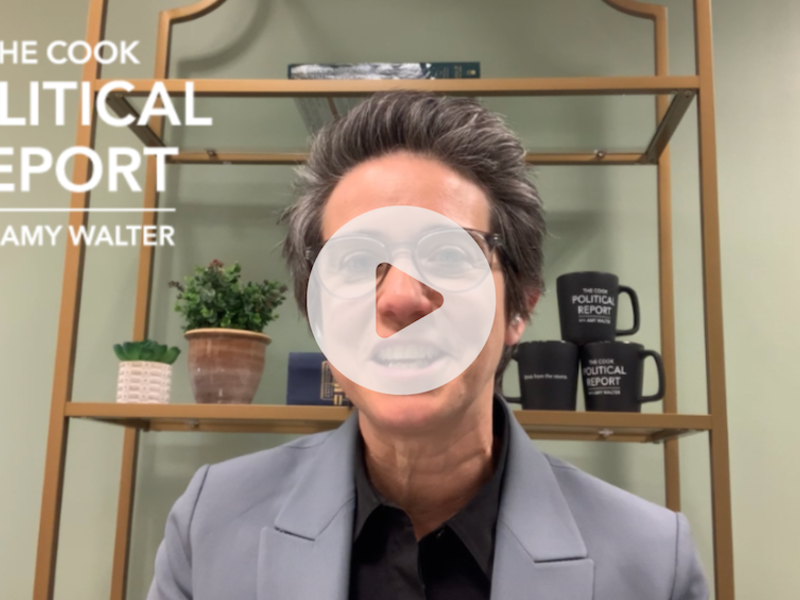
After all the tumult and twists and turns of 2020, it seems a bit risky, if not downright ridiculous, to speculate about the things that will drive our politics in the upcoming year.
But, there are some issues that I think are going to play important, if not staring roles not just in 2021, but in the midterm elections as well.
It’s not an exhaustive list, but is a good place to start.
What happens with COVID?
From his time as a candidate, to his first minutes as president, Joe Biden has made defeating the pandemic his top priority. For the next few months, the White House will be consumed with getting more money to fight the pandemic, facilitating efficient and predictable vaccine distribution and production, and pressing mitigation efforts like masking. In some ways, this is an unenviable task, especially as new, potentially more virulent strains of the virus are discovered. But, Biden benefits from the fact that Pres. Trump left Biden a low bar to clear on the issue. The former president left office with dismal ratings on his handling of COVID (39 percent favorable to 57 percent unfavorable). Moreover, while Biden may have inherited a pandemic, he also inherited the keys to fix it: vaccines. The Biden team doesn't have to find a solution as much as they need to find a way to implement the solution in front of them.
And, of course, getting COVID under control — and having people feeling safer about returning to their normal activities, is likely to spark a consumer spending spree, which will help boost the economy.
A good economy isn't always enough to guarantee a successful midterm election (see: 2018). But, it is certainly better than having a stagnant economy. Or, as Hart Research's Jay Campbell, who runs the CNBC All-America Economic Survey poll, told me, a good economy will "be one less cudgel for Republicans to use against the Democrats, and takes away a reason that Republicans could give to not vote for the Democratic candidates."
As I wrote at the end of last year, the boring but crucial work of competency will be the most important issue for 2021.
But, while the Biden Administration has set its own goals (like getting most Americans vaccinated by the end of the summer), we don't know if voters will be grading him or Democrats on the same curve.
Is the midterm a referendum on Biden or on Trump?
Over the last 86 years, the party of a first-term president has lost seats in a midterm election all but two times — 1934 and 2002. Given that history, Democrats should prepare to see some thinning of its ranks.
However, it's also clear that Donald Trump isn't going anywhere. Unlike previous presidents — especially those who lost re-election, he isn't interested in retreating from public view. He — and those who support his brand of politics — are going to play a much more significant role than we've seen in modern times. Whether it is Trump stepping into competitive primaries to exact revenge on those who voted to impeach him, or a state party voting to censure one of its most promising Senate candidates — the infighting among the GOP will be a factor in determining the kinds of candidates who will be on the ballot in 2022.
It's also unclear at this point what role the attacks on the Capitol on January 6th will have on the opinions of Trump and GOP members of Congress.
As my colleague Charlie Cook has noted, "unreleased survey research—both quantitative polls and qualitative focus groups—since the January 6th attack on the Capitol suggests that between 25 and 30 percent of Trump voters now have very mixed feelings about having backed him. They are less likely to believe that the election was stolen, and they were alarmed by the attack in Washington. They care more about the coronavirus pandemic and the direction of the economy."
These voters aren't necessarily open to voting for Democrats, but they may be less willing to come out and vote for a GOP candidate who identifies him/herself so closely with Trump or the more Trumpian factions in Congress. Given that these Trump-conflicted voters are more likely to be living in a congressional district or county that is more purple than dark-red, their absence could be critical in determining control of the House and Senate.
The other question is whether Democrats want to make Trump the centerpiece of their midterm strategy. Do they want to keep up the pressure on Republicans to answer for the events on January 6th or for its most controversial members like freshman firebrand Rep. Marjorie Taylor Greene? Or, once the impeachment trial is finished, will they try to put Trump — and those attacks — in the rearview mirror?
Of course, so much of this also rests on the question of how active Trump himself will be in the public square. Banned from his favorite form of speech (Twitter), will Trump soon return to his second favorite activity — phoning into friendly cable TV programs?
What happens to all the new voters?
One legacy of the Trump era was record voter turnout. Love for or loathing of Trump drove scores of new voters to the polls in 2018 and 2020. So, what happens to these voters when Trump is no longer in the White House? Both parties are going to be digging into (soon to be updated) voter files to find out who these new voters were — and how they may be able to keep them in their coalition.
Will new voting laws hurt Democrats?
Pres. Trump's (false) allegations of election fraud combined with Democrats' success at swamping the GOP in vote by mail in 2020, has led to calls from Republican legislators around the country to put new restrictions on early voting. This includes everything from rolling back no-excuse voting to eliminating ballot drop boxes to stricter voter ID laws. Democrats see these as brazen attempts to limit access to voting. Despite the fact that multiple investigations and lawsuits have found no widespread evidence of fraud, Republicans argue that they are simply ensuring voter security.
Even so, Democratic governors in states like Pennsylvania and Wisconsin will prevent Republicans from getting much if any traction on making changes to existing election law.
That's why all eyes are focused on battleground states like Georgia and Texas that have a GOP controlled legislature and a Republican Governor.
In Georgia, House Speaker David Ralston has shown little interest in doing away with no-excuse absentee voting, which has been in place in the state since 2005. "Somebody's going to have to make a real strong case to convince me," he said.
Instead, as POLITICO's Zach Montellaro reported, "Republicans are more universally aligned behind requiring absentee voters to submit a copy of an ID either when they request or return a ballot, which would replace the state's signature verification system."
In Texas, the GOP has drafted legislation on everything from banning "local officials from sending unsolicited vote-by-mail applications to registered voters" to requiring "voter registration to be done on paper, not electronically."
However, we don't know if the voting patterns we saw in 2020 (Democrats voting early, while Republicans vote on Election Day) were just a reaction to the political/health crisis moment or if they are more durable changes in behavior. Moreover, will the changes that Republicans push through this year come back to bite them in subsequent elections? For example, making it harder to cast an absentee ballot may have the unintended impact of suppressing some of the GOP's most consistent and loyal voters; senior citizens.
Democrats are also worried that by making it harder to vote by mail, and limiting the number of polling places — especially in crowded urban areas — Republicans could effectively depress their voters' turnout in upcoming elections.
Who will have the upper hand in redistricting?
It's impossible to begin handicapping individual House races until redistricting is completed in 2021. Thankfully, my colleague David Wasserman — one of the most astute and well-sourced experts on redistricting in the country — has outlined the prospects for both parties here. The good news for Democrats; Republicans don't have as many legislative seats as they did back in 2011, and many states took line drawing out of the hands of legislatures and put it into the hands of non-partisan commissions. The good news for Republicans: they still control the line-drawing process in key battleground states like Texas, Florida, Georgia and North Carolina.
Will a 50/50 Senate Stay That Way?
The last time we had a 50-50 Senate, it ended five months later with Vermont's Republican Sen. Jim Jeffords' defection. These days there are fewer moderates in the Republican or Democratic caucuses who could be targets for a defection. Rumors of a Sen. Joe Manchin (D-WV) or Susan Collins (R-ME) switch are not serious.
However, in the event of a tragedy, the death or sudden resignation of a Senator, control of the body (and with it prospects for a Biden agenda), could be altered immediately.
There are currently 15 Democratic senators who sit in states with a Republican Governor: Sens. Mark Kelly and Kyrsten Sinema (Arizona), Raphael Warnock and Jon Ossoff (Georgia), Ben Cardin and Chris Van Hollen (Maryland), Ed Markey and Elizabeth Warren (Massachusetts), Jon Tester (Montana), Jeanne Shaheen and Maggie Hassan (New Hampshire), Sherrod Brown (Ohio), Patrick Leahy and Bernie Sanders (Vermont), and Joe Manchin (West Virginia). Five Republican senators sit in states with a Democratic Governor: Sens. Susan Collins (Maine), Richard Burr and Thom Tillis (North Carolina), Pat Toomey (Pennsylvania), and Wisconsin (Ron Johnson).
However, while most states allow a governor to fill the vacancy immediately with a candidate of their choosing, other states have more specific rules about when and how a vacancy is filled. For example, in Arizona, North Carolina and Maryland, the governor must appoint a senator from the same party as the senator he/she is replacing. In Wisconsin, the senate seat remains vacant until a special election is held to fill the seat. The National Conference of State Legislatures provides a list of rules for each state here.
Can we trust polling?
In the immediate wake of Election Day 2020, a number of pollsters and poll watchers gave their takes on why polling — both public and private — overestimated the Democrats' share of the vote. Their theories ranged from a miscalibration of turnout, especially an underestimation of enthusiasm for Trump, to late-breaking movement to the GOP to the challenges of polling during a pandemic.
Mostly though, folks across the board seem to agree that Trump turned out voters who polls could not or did not find.
Or another way to think of this is that when Trump was not on the ballot — 2017 and 2018 — polling pretty much hit the mark. But, when Trump was on the ballot in 2016 and 2020, the polls failed to capture the likely electorate accurately.
So, what does this mean for 2022? Should we assume that no Trump on the ballot means more accurate polling? Or, is this a more systemic problem? That, as Nate Silver writes, it's hard to get a truly representative sample of people on the phone.
A number of pollsters have publicly pledged to take a deep dive into their data once voter files are updated.
For now, however, we are going to have to be comfortable with a degree of discomfort. Despite advances made in data analytics and collection, the reality is that campaign polling is not as precise as people would like it to be. The answer isn't to disregard polls. Instead, it is to make them part of a more well-rounded political diet that includes, as my colleague David Wasserman has suggested, analysis of candidate quality, the district's fundamentals, and the political environment within that district.








Subscribe Today
Our subscribers have first access to individual race pages for each House, Senate and Governors race, which will include race ratings (each race is rated on a seven-point scale) and a narrative analysis pertaining to that race.